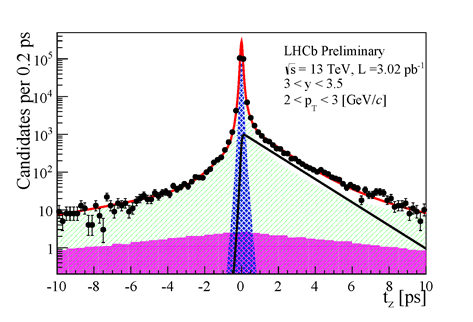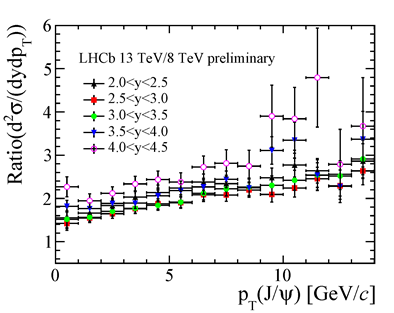Measurement of J/ψ production cross-sections in pp collisions at 13 TeV.
[ σ(prompt Jψ) = 15.35±0.03±0.85 μb; σ(Jψ-from-b-hadron) = 2.36±0.01±0.13 μb; σ( bb) = 518±2±53 μb ]
At the EPS-HEP 2015 conference in Vienna the LHCb collaboration has presented today the first measurement of the probability to produce a J/ψ meson in proton-proton collisions at 13TeV. Using this measurement they also determined the rate at which beauty quarks are produced at this new, higher energy.
The first task of physicists when operating an experiment at a higher energy is to measure the probabilities of well-known processes. These can be compared to theoretical predictions to establish a firm base upon which to build searches for new physics. The probabilities are related to quantities known as “cross-sections”, σ. How to measure these probabilities is explained in the “How bright is the LHC?” news.
The J/ψ was discovered on 11 November 1974. The importance of this discovery is highlighted by the fact that the subsequent, rapid changes in high-energy physics at the time have become collectively known as the “November Revolution”. The spokespersons of the experiments who made this discovery, Richter and Ting, were rewarded for their shared discovery with the 1976 Nobel Prize in Physics. The J/ψ is composed of a charm quark c and an anti-charm quark c. At the LHC, collisions containing J/ψ meson decays are used as an excellent tool for detector calibration, as well as for the first cross-section measurements at new energy frontiers.
The production of J/ψ mesons can be described in two stages. In the first stage a cc quark pair is produced and in the second stage the cc pair forms a J/ψ meson. The first stage can be calculated with the theory of strong interactions, QCD. On the other hand, the second stage, after forty years of theoretical and experimental efforts, is still not fully understood. The J/ψ mesons that are produced in this way are called “prompt J/ψ”. J/ψ mesons can also be observed as a product of of the decays of beauty hadron (containing b quarks) and therefore this component is called “J/ψ-from-b-hadron”.
The two components are clearly visible in the left image which shows the J/ψ decay time distribution with respect to the pp collision time. The data are shown as black points with error bars, the solid red line shows the best data interpretation while the prompt J/ψ contribution is shown in cross-hatched blue. The J/ψ-from-b-hadron contribution in black falls exponentially with a time constant characteristic to the lifetime of beauty hadrons. The right image shows an example of the ratio distribution between the rate of J/ψ-from-b-hadron production at 13 TeV and 8 TeV. The cross-section of J/ψ-from-b-hadron decay is used to compute the total beauty quark pair bb cross-section. The expected rise of the beauty particle production rate of about a factor 2 with respect to run 1 at 8 TeV is confirmed by the data. This increase in rate will enable LHCb to obtain even more precise, interesting and, hopefully, surprising results in the LHC run 2 as explained by Barbara, Mika and Patrick.
Read more in the LHCb presentation in Vienna, in the LHCb publication and in the LHCb seminar at CERN.


